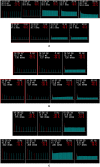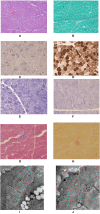Abnormal decrement on high-frequency repetitive nerve stimulation in congenital myasthenic syndrome with GFPT1 mutations and review of literature
- PMID: 36188410
- PMCID: PMC9520358
- DOI: 10.3389/fneur.2022.926786
Abnormal decrement on high-frequency repetitive nerve stimulation in congenital myasthenic syndrome with GFPT1 mutations and review of literature
Abstract
Objectives: Congenital myasthenic syndrome (CMS) is a clinically and genetically heterogeneous group of inherited disorders characterized by neuromuscular junction defects. Mutations in GFPT1 have been shown to underlie CMS. An increasing number of patients with CMS due to mutations in GFPT1 have been reported. However, a comprehensive review of clinical and genetic analyses of GFPT-related CMS worldwide is lacking, especially, given that the common or hotspot mutations in GFPT1 have not been reported. Here, we described the clinical and genetic findings of three patients with GFPT1 mutations from southwestern China and reviewed the clinical and genetic features of patients with GFPT1-related CMS worldwide.
Methods: Clinical, laboratory, electrophysiological, myopathological, and genetic analyses of three patients with GFPT1-related CMS from southwestern China were conducted, and a review of previously published or reported cases about congenital myasthenic syndrome with GFPT1 mutations in the PubMed database was made.
Results: The clinical, laboratory, electrophysiological, and myopathological features by muscle biopsy of three patients with GFPT1-related CMS were consistent with those of previously reported patients with GFPT1 mutations. Additionally, an abnormal decrement in high-frequency RNS was found. Two different homozygous missense mutations (c.331C>T, p.R111C; c.44C>T, p.T15M) were detected by whole-exome sequencing (WES) or targeted neuromuscular disorder gene panels.
Conclusion: A distinct decremental response to high-frequency RNS was found in three patients with GFPT1-related CMS from southwestern China, which has never been reported thus far. In addition, the location and degree of tubular aggregates (TAs) seemed to be associated with the severity of clinical symptoms and serum creatine kinase levels, further expanding the phenotypic spectrum of GFPT1-related CMS. Lastly, some potential hotspot mutations in GFPT1 have been found in GFPT1-CMS worldwide.
Keywords: GFPT1; RNS; congenital myasthenic syndrome; high-frequency; repetitive nerve stimulation; tubular aggregates.
Copyright © 2022 An, Chen, Lei, Li, Xu and He.
Conflict of interest statement
The authors declare that the research was conducted in the absence of any commercial or financial relationships that could be construed as a potential conflict of interest.
Figures


References
LinkOut - more resources
Full Text Sources
Miscellaneous

